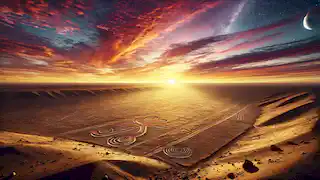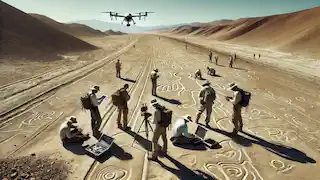The Tale of the Nazca Lines
Reading time: 9 min

About this story: The Tale of the Nazca Lines is a Historical Fiction from Peru set in the Ancient This Descriptive tale explores themes of Nature and is suitable for Adults. It offers Historical insights. Unravel the mysteries of Peru's ancient desert geoglyphs.
In the vast desert plains of southern Peru lies one of the world’s most mysterious and awe-inspiring archaeological wonders—the Nazca Lines. These enormous geoglyphs, etched into the arid land over 2,000 years ago, have puzzled researchers, archaeologists, and historians for decades. What purpose did they serve? Who created them? How did the ancient Nazca people, without modern tools or technology, manage to design such complex and massive figures with astonishing precision? This is a story of mystery, science, culture, and the human drive to leave an indelible mark on history.
The tale of the Nazca Lines begins long before the desert was carved with enigmatic symbols. It’s a tale rooted in the heart of an ancient civilization that flourished on the dry coastal plains of Peru. The Nazca civilization, which thrived between 200 BCE and 600 CE, was a culture steeped in spirituality, astronomy, and a deep understanding of their environment. Their connection to the earth and sky would give rise to one of the most perplexing legacies of human ingenuity.
The Desert’s Silent Artifacts
To fully appreciate the marvel of the Nazca Lines, one must first understand the unforgiving nature of the desert they inhabit. The Pampa de San José, where the Nazca Lines are located, is one of the driest places on Earth. The arid conditions, combined with the stable climate and minimal rainfall, have helped preserve the geoglyphs for millennia. These environmental factors were undoubtedly known to the ancient Nazca people, who recognized the desert’s unyielding silence and permanence as a perfect canvas for their grand designs.
But what exactly are these designs? The Nazca Lines are made up of hundreds of individual figures, ranging from simple geometric shapes to complex depictions of animals, plants, and humans. Some of the most famous figures include the hummingbird, the monkey, the spider, and the condor. Each figure is enormous, spanning hundreds of meters, and only fully visible from the sky. This has led to much speculation about how these ancient people could have created such massive works of art without aerial assistance.
Researchers have proposed several methods the Nazca might have used to construct the lines. Some suggest they employed rudimentary tools like stakes and ropes to map out the figures on the ground, using an intricate system of measurements. Others believe the designs were created by slowly removing the reddish-brown top layer of soil to reveal the lighter-colored earth underneath. The contrast between the two layers is what makes the lines so visible.
Creation Myths and Symbolism
The Nazca Lines are not just impressive for their size and complexity; they are also steeped in cultural significance. Many scholars believe that the geoglyphs were part of the Nazca people’s religious and ceremonial practices. Their intricate designs may have been offerings to deities, particularly those associated with water and fertility. In a desert environment where water was scarce and life depended on the rivers and irrigation systems, it’s not difficult to see why the Nazca would turn to spiritual means to secure this precious resource.
According to some interpretations, the geoglyphs might have been created as a form of communication with the gods. The Nazca believed in a pantheon of deities who controlled the forces of nature, and the figures could have been a way of sending messages to these higher powers. The sheer scale of the geoglyphs, visible from the heavens, suggests that they were intended for celestial beings to view, not humans.
One popular theory links the lines to astronomical events and celestial bodies. Some researchers argue that the geoglyphs were aligned with certain constellations or marked important solar and lunar events. For example, the straight lines may have been used as markers for the summer and winter solstices, helping the Nazca predict changes in the seasons, crucial for agricultural planning. However, this theory remains debated, as not all of the lines seem to correspond with known astronomical patterns.
The Mystical Spider
One of the most iconic and frequently discussed geoglyphs is the spider. The spider, measuring nearly 45 meters in length, is meticulously crafted with long legs and an extended body. Many believe it represents a species of spider known for its role in rain rituals. In Nazca mythology, spiders were associated with fertility, rain, and agricultural cycles. Some researchers speculate that the spider geoglyph was a symbolic request for rain, crucial for survival in the harsh desert climate.
Yet, the spider figure is shrouded in even more mystery when we consider the species it might represent. Some suggest that the Nazca’s detailed knowledge of spiders hints at a deeper understanding of biology, possibly passed down through generations of observation. Still, why they chose to immortalize the spider in such a grand way remains a subject of speculation.

The Pilgrimage Paths
While the animal and plant figures have captured much of the public’s attention, the straight lines and geometric shapes that crisscross the desert are equally fascinating. Some of these lines stretch for miles, cutting across the landscape in perfectly straight paths. Unlike the animal figures, which are curvilinear and complex, these lines are simple, straight, and precise.
One compelling theory suggests that these lines were used as pilgrimage routes or sacred paths, leading participants to important religious sites or shrines. The Nazca civilization was deeply spiritual, and religious pilgrimages might have played a significant role in their culture. The straight lines could have served as ceremonial roads, guiding the faithful toward the center of spiritual activities.
As the Nazca traversed these pathways, they may have engaged in rituals to honor their gods or ask for favors such as rain, fertility, and good harvests. The act of walking these lines would have been a spiritual journey in itself, connecting the physical world with the divine.
Environmental Understanding and Innovation
Beyond their spiritual and symbolic importance, the Nazca Lines also reflect the Nazca people’s deep understanding of their environment. The desert’s arid climate made agriculture a constant challenge, yet the Nazca civilization was remarkably adept at harnessing the limited water resources available to them. They developed sophisticated irrigation systems, including underground aqueducts called *puquios*, which allowed them to farm the desert and sustain a large population.
Some researchers believe that the Nazca Lines, particularly the straight lines, were linked to these irrigation systems. The lines may have been used to map out sources of water or guide water to where it was needed most. Alternatively, they might have been part of ceremonies designed to appease the gods and ensure the continued flow of water.
The Nazca’s agricultural innovations were impressive, especially considering the harsh desert conditions they faced. They grew crops like maize, beans, squash, and cotton, and they domesticated animals such as llamas and guinea pigs. These achievements demonstrate that the Nazca were not just skilled artists and astronomers but also resourceful engineers.
Rediscovery in the Modern Era
For centuries, the Nazca Lines remained largely unknown to the outside world, hidden in the vast Peruvian desert. It wasn’t until the early 20th century that they were rediscovered by Western explorers and scholars. One of the most important figures in the study of the Nazca Lines was German mathematician and archaeologist Maria Reiche. She devoted much of her life to researching the geoglyphs, meticulously mapping them and advocating for their preservation.
Reiche believed that the lines were related to astronomical phenomena, particularly the movements of the sun, moon, and stars. Her work drew international attention to the Nazca Lines, and she played a key role in ensuring their protection. Thanks to her efforts, the Nazca Lines were declared a UNESCO World Heritage Site in 1994, ensuring that future generations could continue to marvel at this ancient wonder.

Theories and Speculation
Despite decades of study, the true purpose of the Nazca Lines remains elusive. Over the years, a wide range of theories has emerged, from the plausible to the far-fetched. Some believe the lines were part of elaborate irrigation systems or agricultural markers, while others argue that they had a purely religious or ceremonial function.
One of the more controversial theories suggests that the Nazca Lines were created by extraterrestrial beings or were used as landing strips for ancient alien spacecraft. This idea, popularized by authors like Erich von Däniken in the 1960s, has been widely debunked by archaeologists and scientists. However, it has captured the public’s imagination and contributed to the sense of mystery surrounding the geoglyphs.
Another theory posits that the lines were a form of giant calendar, used to mark important celestial events. While some of the figures do appear to align with astronomical features, there is no conclusive evidence that the Nazca Lines were used in this way. The true meaning of the geoglyphs may never be fully understood, adding to their enduring mystique.
Preservation and Challenges
Today, the Nazca Lines face several threats, both natural and man-made. The increasing development of infrastructure in the region, including roads and highways, has led to concerns about the preservation of the geoglyphs. In 2014, a group of environmental activists caused damage to one of the lines during a protest, sparking outrage and calls for stricter protection measures.
Climate change is another growing concern. While the desert’s dry climate has helped preserve the lines for centuries, changes in weather patterns could threaten their longevity. Increased rainfall, for example, could cause erosion and damage the delicate figures etched into the earth.
Efforts are being made to protect the Nazca Lines, including the establishment of a protective buffer zone around the site. However, balancing the needs of local communities, tourism, and preservation remains a complex challenge.

The Nazca Legacy
Though the Nazca people vanished long ago, their legacy endures in the lines they left behind.
These geoglyphs are a testament to their creativity, ingenuity, and spiritual devotion. They offer a window into a world that is both ancient and enigmatic, a world where art, science, and religion were intertwined in ways we are still trying to understand.
The Nazca Lines remind us that even in the harshest environments, humanity has always sought to leave its mark—to create, to innovate, and to connect with forces greater than ourselves. The desert may be silent, but the lines speak volumes, telling the story of a people who looked to the stars and carved their dreams into the earth.

Conclusion
The tale of the Nazca Lines is one of mystery, discovery, and awe. It is a story that has captivated generations of researchers and travelers, inspiring endless theories and speculation. As we continue to study these ancient geoglyphs, we are reminded of the enduring power of human creativity and the lengths to which civilizations will go to make sense of their place in the universe.
The Nazca Lines remain one of the world’s most fascinating archaeological sites, a silent testament to the brilliance and vision of an ancient people. Though we may never fully unravel their secrets, the lines will continue to inspire wonder and curiosity for generations to come.

















